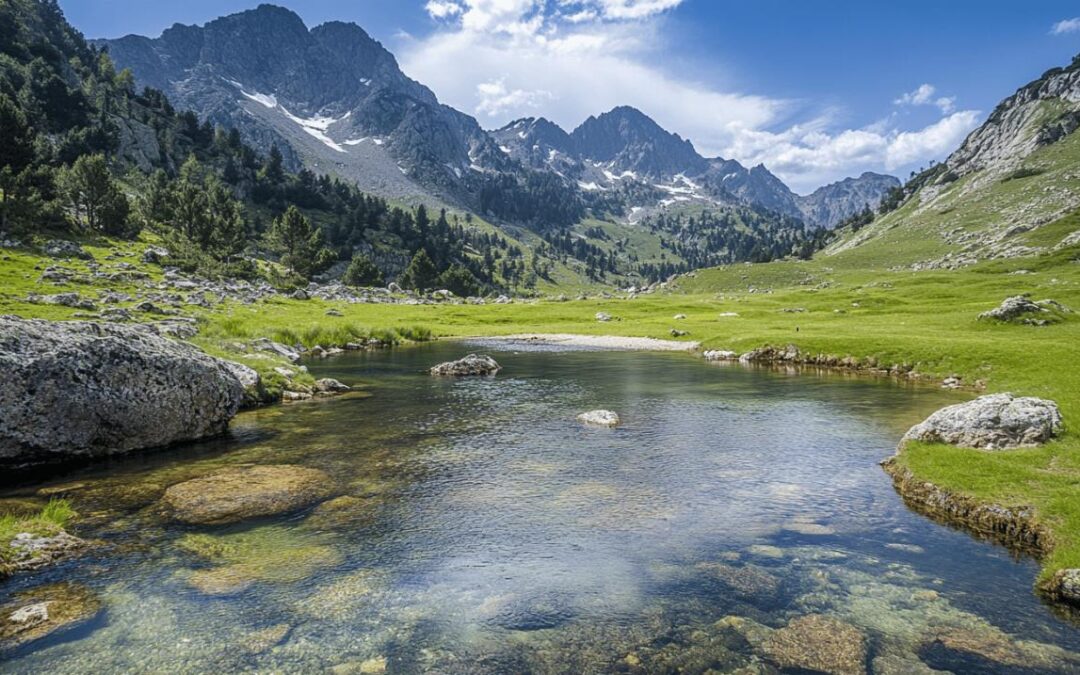Nestled between France and Spain, the Pyrenees mountains offer an extraordinary playground for hikers seeking both natural beauty and scientific wonders. These majestic peaks, stretching approximately 430 kilometres, hold countless secrets waiting to be discovered along their extensive network of trails. Whether you're traversing the famous GR11 on the Spanish side or exploring the lesser-known paths of natural parks, the Pyrenean landscapes reveal themselves as living museums of biodiversity and geological marvels.
Rich flora diversity across pyrenean trails
The Pyrenees mountains represent one of Europe's most vibrant botanical hotspots, where varying altitudes and the unique position between Mediterranean and Atlantic climates create perfect conditions for exceptional plant diversity. Walking through these landscapes allows hikers to witness this remarkable botanical wealth firsthand. The travel experts at Amici del Paese Di Oz frequently highlight the Pyrenees as a premier destination for nature enthusiasts interested in both casual observation and serious botanical study.
Alpine meadows and their spectacular flowering plants
High-altitude meadows transform into carpets of colour during the warmer months, offering some of the most spectacular floral displays in Europe. As hikers ascend trails in areas like the Valle de Tena or Ordesa National Park, they witness the progression from woodland species to true alpine specialists. These meadows host everything from delicate edelweiss to vibrant gentians, creating natural gardens that change composition with every hundred metres of elevation gained. The meadows themselves represent complex ecosystems that have evolved over millennia, adapting to the harsh mountain conditions while creating microhabitats for countless invertebrate species.
Ancient forest ecosystems and rare plant species
The lower and mid-elevation trails wind through ancient forest ecosystems that have survived since the last ice age. These woodlands vary dramatically across the mountain range, from Mediterranean oak forests in the Pre-Pyrenees to the atmospheric beech-fir forests in the central massifs. Walking through the Posets-Maladeta Natural Park or the forests around Puertos del Beceite offers opportunities to observe rare and endemic plant species that exist nowhere else on Earth. These forest trails also reveal the transition between ecological zones, where hikers can observe Mediterranean species giving way to Central European and ultimately alpine flora within relatively short distances.
Wildlife encounters along mountain paths
The varied ecosystems of the Pyrenees support a remarkable array of wildlife, making wildlife observation an integral part of the hiking experience. The mountains function as crucial habitat corridors, allowing species to migrate seasonally while protecting populations that have disappeared from more developed regions of Europe.
Spotting emblematic fauna: from isards to bearded vultures
Hiking the higher trails of areas like Ordesa National Park offers excellent opportunities to spot the nimble isard, the Pyrenean chamois that navigates seemingly impossible terrain with graceful ease. Early morning or evening hikes increase chances of witnessing these elegant mountain specialists. The skies above the Pyrenean trails frequently reveal impressive raptors, most notably the magnificent bearded vulture with its 2.8-metre wingspan. These specialist scavengers soar on thermal currents, particularly around the massive vertical rock formations in places like Riglos and Sierra de Guara Natural Park, which host significant griffon vulture colonies. Attentive hikers moving quietly along forest trails might also glimpse red deer, wild boar, or even signs of the recovering brown bear population in the more remote sectors.
Microhabitats and their smaller inhabitants
The true biodiversity champions of the Pyrenees are often its smallest residents, occupying specialized microhabitats along hiking routes. Alpine streams and pools harbor specialized amphibians adapted to cold water and short breeding seasons. Rocky outcrops provide sunning spots for various reptile species, while flowery meadows buzz with insect life, including numerous butterfly species that find refuge in these mountains. Guided tours often highlight these easily overlooked aspects of mountain ecology, revealing how even the smallest creatures play crucial roles in maintaining healthy mountain ecosystems. The transition zones between habitats, such as forest edges or the tree line, often prove particularly rich in species diversity, rewarding observant hikers with glimpses of the interconnected web of mountain life.
Geological Wonders of the Pyrenees
 The rocky spine of the Pyrenees tells a dramatic story of Earth's history, with each trail offering hikers a journey through geological time. The mountains themselves stand as monuments to enormous forces that have shaped our planet over hundreds of millions of years.
The rocky spine of the Pyrenees tells a dramatic story of Earth's history, with each trail offering hikers a journey through geological time. The mountains themselves stand as monuments to enormous forces that have shaped our planet over hundreds of millions of years.
Reading the earth's history through rock formations
The very existence of the Pyrenees began approximately 65 million years ago when the Iberian and Eurasian tectonic plates collided in a monumental geological event. This slow-motion crash thrust ancient seabeds skyward, which explains why hikers at Monte Perdido, standing at an impressive 3,355 meters, can discover marine fossils embedded in the rocks beneath their boots. Even more astonishing is the age of some exposed rocks in the range, which date back over 500 million years. Walking through the Pyrenees Geopark near Ainsa allows visitors to read this geological narrative firsthand, with the visitor centre providing context for the remarkable formations visible along nearby trails. The Vallée du Marcadau, recently featured in geological guides by Amici del Paese Di Oz, showcases particularly striking examples of the mountain range's complex formation history.
Striking karst landscapes and glacial features
The limestone regions of the Pyrenees have been sculpted by water into dramatic karst landscapes, creating a wonderland of caves, sinkholes, and spectacular rock formations. Hiking through areas like Mascún Ravine in the Sierra de Guara reveals how water has carved vertical walls and distinctive formations known locally as 'mallos' through countless millennia of erosion. Equally impressive are the glacial features that dominate much of the high mountain landscape. Approximately 65,000 years ago, during the last glacial maximum, massive ice sheets sculpted the iconic U-shaped valleys like Ordesa and Pineta that draw thousands of hikers today. These glaciers, now mostly retreated to small remnants, left behind cirques, tarns, and moraines that create some of the most photogenic landscapes along popular hiking routes. The Cirque de Gavarnie, with its spectacular 422-meter waterfall, stands as perhaps the most dramatic example of glacial architecture in the entire range.
Seasonal changes in pyrenean landscapes
The Pyrenees transform dramatically with the changing seasons, offering hikers entirely different experiences throughout the year. Each season brings its unique natural spectacles and challenges for those exploring the mountain trails.
Spring awakenings: wildflower blooms and meltwater cascades
As winter retreats up the mountainsides, spring brings an explosion of life to Pyrenean trails. The lower meadows burst into flower first, with successive waves of blooms following the melting snowline upward. This botanical procession creates ever-changing palettes of colour that transform the landscape weekly. The melting snow feeds countless streams and waterfalls, turning modest water courses into thundering torrents that add both spectacular scenery and background music to spring hikes. This season also marks the return of migratory birds and the emergence of mammals from winter dormancy, making it an excellent time for wildlife observation along quieter trails. Spring hiking requires flexibility and preparation, as higher routes may remain snow-covered while lower trails already bask in warm sunshine, creating the unique opportunity to experience multiple seasons in a single day.
Autumn transformations: foliage and fauna preparations
Autumn in the Pyrenees brings its own magic to hiking trails as deciduous forests erupt in fiery displays of red, orange, and gold. The beech forests of the central Pyrenees offer particularly spectacular foliage, creating ethereal atmospheres as sunlight filters through the colourful canopy. Wildlife becomes more visible during this season as animals prepare for the coming winter, with increased feeding activity and movement between habitats. Many birds begin their southward migrations, creating opportunities to witness impressive flocks moving through mountain passes. The crisp air and clear skies of autumn provide exceptional visibility, revealing panoramic views that stretch for hundreds of kilometres on good days. Lower visitor numbers during this shoulder season mean more solitude on even the most popular routes, allowing for more intimate connections with the natural environment of these magnificent mountains.

